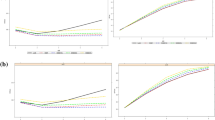Abstract
Fractional factorial experiments are very useful in identifying active factors and the conventional method of analysis may not always detect these active factors. Box and Meyer (1993) provided a Bayesian method to compute the posterior probability that a factor is active. Their method does not indicate whether main effects or interactions are active. Following their approach in a non-Bayesian way, we will present a heuristic analysis which determines the active main effects and small order interactions in any 2n fractional factorial design. It may be noted that the method given by Box and Meyer has greater flexibility and wider applicability over the method given in this paper; however, our method is a simpler alternative for 2n experiments that determines active main effects and small order interactions.
Similar content being viewed by others
Author information
Authors and Affiliations
Corresponding authors
Additional information
No SimplePara
Rights and permissions
About this article
Cite this article
Raghavarao, D., Altan, S. A heuristic analysis of highly fractionated 2n factorial experiments. Metrika 58, 185–191 (2003). https://doi.org/10.1007/s001840200236
Issue Date:
DOI: https://doi.org/10.1007/s001840200236




